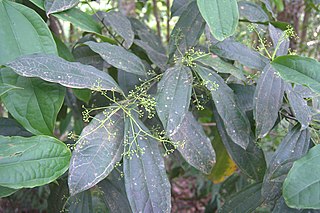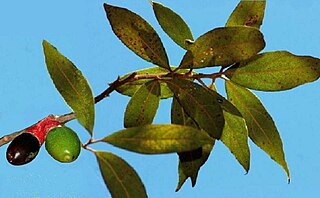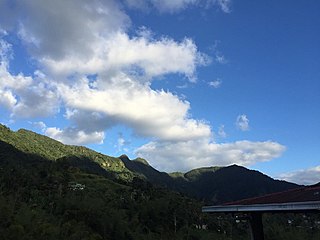
Persea is a genus of about 150 species of evergreen trees belonging to the laurel family, Lauraceae. The best-known member of the genus is the avocado, P. americana, widely cultivated in subtropical regions for its large, edible fruit.

Ocotea is a genus of flowering plants belonging to the family Lauraceae. Many are evergreen trees with lauroid leaves.

Aiouea is a genus of shrubs and trees in the family Lauraceae. It is native to tropical forests and montane forests of North and South America. The name is a curiosity because it consists entirely of vowels.

Aniba is an American neotropical flowering plant genus in the family Lauraceae. They are present in low and mountain cloud forest in Caribbean islands, Central America, and northern to central South America.

Beilschmiedia is a genus of trees and shrubs in family Lauraceae. Most of its species grow in tropical climates, but a few of them are native to temperate regions, and they are widespread in tropical Asia, Africa, Madagascar, Australia, New Zealand, North America, Central America, the Caribbean, and South America. The best-known species to gardeners in temperate areas are B. berteroana and B. miersii because of their frost tolerance. Seeds of B. bancroftii were used as a source of food by Australian Aborigines. Timbers of some species are very valuable.

Mezilaurus is a genus of plant in the family Lauraceae. It is a neotropical genus consisting of 18-27 species, mostly hardwood evergreen trees, occurring from Costa Rica to the southeast of Brazil. 13 species have been identified in Brazil, distributed mostly in the Amazon region. In Rio de Janeiro state only M. navalium (Allemão) Taub. ex Mez has been recorded. Some species have been reported within the Cerrado and in semideciduous forest surrounding the Pantanal Matogrossense. The name Mezilaurus refers to its similar appearance to the genus Laurus.

Nectandra is a genus of plant in the family Lauraceae. They are primarily Neotropical, with Nectandra coriacea being the only species reaching the southernmost United States. They have fruit with various medical effects. Sweetwood is a common name for some plants in this genus.
Ocotea benthamiana is a species of Ocotea in the plant family Lauraceae. It is an evergreen tree to 25–35 m tall. Its conservation status is classed as vulnerable.
Ocotea catharinensis is a member of the plant family Lauraceae. It is a slow-growing evergreen, a valuable hardwood tree of broad ecological importance, and it is threatened by habitat loss and by overexploitation for its timber and essential oils.

Ocotea porosa is a species of plant in the Lauraceae, often placed in the related genus Phoebe. It is commonly called imbuia or Brazilian walnut because its wood resembles that of some walnuts. The tree is a major commercial timber species in Brazil, used for high-end furniture, mostly as decorative veneers, and as flooring. The wood is very hard, measuring 3,684 lbf on the Janka scale. The wood is also fragrant with hints of nutmeg and cinnamon. The tree is also a popular horticultural tree in subtropical regions of the world. In its native habitat it is a threatened species.
Urbanodendron is a genus of flowering plants in the family Lauraceae. The three species are native to Brazil.

Toro Negro State Forest is one of the 21 forests that make up the public forests system in Puerto Rico. It is also Puerto Rico's highest cloud forest. It is in the Cordillera Central region of the island and covers 8,204 cuerdas, of mountains. Toro Negro's mountains have heights reaching up to 4,400 feet (1,300 m) and include Cerro de Punta, Cerro Jayuya and Cerro Rosa, the three highest peaks in the island. Nested among these mountains is Lake Guineo, the island's highest lake. The forest has 18 kilometers (11 mi) of trails, an observation tower, two natural swimming pools (Spanish:"charcos"), camping and picnic areas, nine rivers, and numerous creeks and waterfalls. The forest spans areas within the municipalities of Ponce, Jayuya, Orocovis, Ciales, and Juana Díaz, and consists of seven non-contiguous tracts of land. The largest contiguous segment of the forest is located in the municipalities of Ponce and Jayuya. Some 40% of the area of Toro Negro State Forest is located in Ponce's Barrio Anón.

Endlicheria is a neotropical plant genus consisting of approximately 60 species, occurring mostly in northern South America and the Amazon region. Most species are medium-sized trees, sometime up to 40 metres in height, but a few species are shrubs. DNA molecular data shows that it is closely related to Rhodostemonodaphne and Ocotea.
Rhodostemonodaphne is a genus of flowering plants in the family Lauraceae. It is a neotropical genus consisting of approximately 41 species occurring in Central America and northern South America. This genus has many species that are valued for timber. The classification of the genus is unclear since the species in the genus fall into a well-supported but unresolved clade that also includes species with unisexual flowers currently placed in the genera Endlicheria and part of Ocotea.

Los Tres Picachos State Forest is one of the 20 forests that make up the public forest system of Puerto Rico. The forest is located in the Central Mountain Range or Cordillera Central, along the Los Tres Picachos mountain ridge, one of the island's highest mountains, named after the distinctive three peaks of the highest mountain in the forest. The state forest is located in the municipalities of Jayuya and Ciales.










